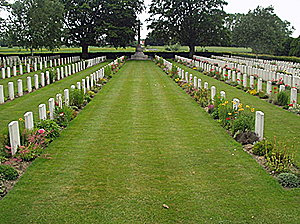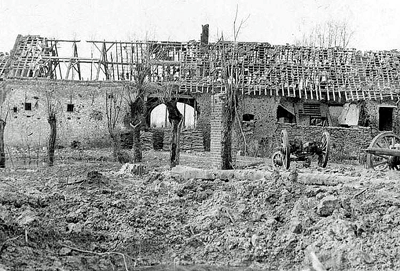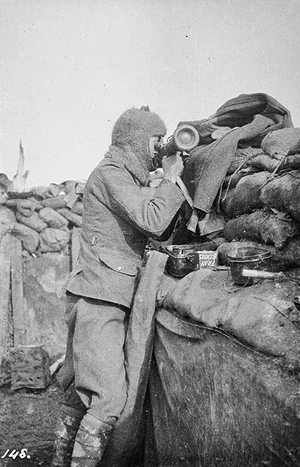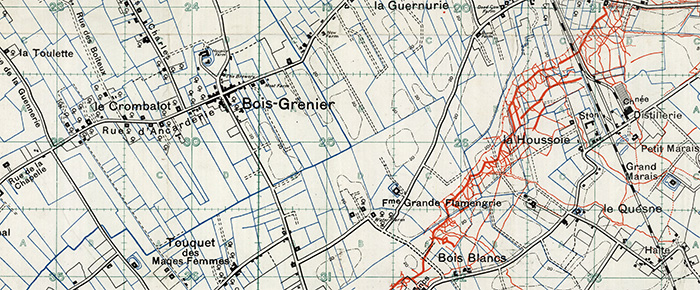First World War Project
Walter George SMITH (of Newnham)
b. Q1 1889 - Egerton, Kent; Corporal, Acting Sergeant, Service Number L/8093 |

Corporal Walter George Smith was born early in 1889, into an Egerton family of several generations, near West Ashford. He was one of eight children born to Walter George and Agnes (née Day), both Egerton born; marriage registered in nearby West Ashford. His father and earlier generations were labourers (general and agricultural). However, Walter George (senior) moved in pursuit of work to Pluckley (1883), Egerton (1889), Newnham (1899) and Bistock Farm, Doddington (1901 to at least 1914). Bistock Farm sits south of Lynsted/Erriotwood on the Doddington Road. Walter (junior) had two elder siblings William Day and Alice and five younger siblings - Flora, Grace, Bertha, Kate and Frances Audrey.
Walter's older brother, William, became a farm yardman at 16 years and this may well have been the path followed in the steps of their father, instead, Walter followed his brother into The Buffs when he was about 16 years old in c.1904 to serve overseas (more is said of his brother separately, below). Walter joined the 2nd Battalion, The Buffs, who were stationed in South Africa (1900 -1907) and Hong Kong and Singapore (1907 - 1912). He is recorded as being a Lance-Corporal in "India and Singapore" in 1911 - his birth-place being given as Lenham on this occasion. He was demobilised shortly before the First World War, but, as an experienced soldier, he immediately re-enlisted to join "C" Company, 1st Battalion The Buffs (East Kent Regiment) with the service number L/8093. His name is amongst the other "Old Contemptibles", those who were posted as part of the British Expeditionary Force and received the "Mons Star" - 1914 Star Medal.
 Walter entered the theatre of war on 9th November 1914 when he and his comrades were quickly moved up to join the 3rd Corps, 16th Brigade, 6th Division, where the 1st Battalion The Buffs had moved on 3rd November to the entrenchments at Grande Flamengrie Farm (see right) in stark snow-laden winter conditions. Earlier, during October (18th and 20th, in particular), 1st Battalion The Buffs had suffered significant losses at Radinghem and desperately needed drafts of new men as they moved into the Bois-Grenier sector (see below for a fuller description of the earlier losses).
Walter entered the theatre of war on 9th November 1914 when he and his comrades were quickly moved up to join the 3rd Corps, 16th Brigade, 6th Division, where the 1st Battalion The Buffs had moved on 3rd November to the entrenchments at Grande Flamengrie Farm (see right) in stark snow-laden winter conditions. Earlier, during October (18th and 20th, in particular), 1st Battalion The Buffs had suffered significant losses at Radinghem and desperately needed drafts of new men as they moved into the Bois-Grenier sector (see below for a fuller description of the earlier losses).
The War Diary for December 1914 describes the harsh conditions in which Walter fought.
Having survived ten years in other theatres of war, the 25-year-old veteran soldier, Walter, appears to have been the 146th recorded death from the 1st Battalion, The Buffs (East Kent). His death that day was one of only two recorded from his Battalion that day. The Commonwealth War Graves Commission records his field commemoration in Y-Farm Military Cemetery, Bois-Grenier, Grave Reference - E. 49. This Military Cemetery was begun in March 1915, so Walter's body will have been brought in at a later date from another graveyard south of Armentieres (so-called "concentration").
His detailed military records are amongst those that failed to survive the destruction of World War 2, which that laid waste to so many WW1 records. So Walter's medal card is very nearly the only contemporary record. It shows Walter earned the 14-Star with clasp, British War and Victory Medals.
The Daily Mail at this time regularly recorded the casualties as reports emerged from the theatre of war; in their 22nd February 1915 edition, they reported his death as "Under Date 4th January - SMITH, 8093, Corporal W., The Buffs."
 More locally, the death of Walter was recorded by the Folkestone, Hythe, Sandgate & Cheriton Herald on Saturday 16th January 1915:
More locally, the death of Walter was recorded by the Folkestone, Hythe, Sandgate & Cheriton Herald on Saturday 16th January 1915:
"KILLED BY A GLANCING BULLET.
Sergt. Walter George Smith, of the East Kent Buffs, was killed at the front on Christmas day in a peculiar manner. A soldier was on the edge of the trench with a range finder (see right), when a bullet hit the instrument, glanced off the brass work, and struck Sergt. Smith full in the forehead, killing him instantly. The deceased has been in the Buffs for ten years and had seen service in Africa, India, and China. He had left the service but a few months when he was called up and stationed at Dover, whence some two months ago he was transferred to the firing line. His parents reside near to Sittingbourne, but two of his sisters are staying in Castle Hill-avenue, Folkestone. They have two other brothers at the front."
You will notice he is reported locally as "Sergeant" on this occasion, although this was only an "acting" rank on his death. The two brothers referred to were Herbert Edward Smith and William Day Smith.
Circumstances leading up to the death of Walter George Smith
The 1st Battalion, The Buffs, shortly before Walter joined it, took part in a violent and costly battle. Thereafter, trench warfare became the norm.
In the period October-November 1914, there were four simultaneous battles in the region of Ypres ("the First Battle of Ypres"). These battles had to be won by the Allied forces if the Channel was to be secured (to permit the flow of troops and materiel) and the German forces brought to a halt.
Against superior German forces in their sector, the Buffs formed part of the Estaires-Fournes Line often referred to as the "Battle of Armentieres" that stretched from 13th October to 2nd November. Attacks and counter-attacks settled into trench warfare and the pattern was set for the subsequent grinding years of attrition on land.*
In this battle, the 1st Battalion lost 24 men on 18th October and 50 on the 20th October, which explains the importance of the flow of new recruits that included Walter Smith on 9th November 1914.

On 18th October, the 3rd Corps (containing the 16th Brigade in which sat the 6th Division, of which the 1st Battalion, the Buffs was a part) was instructed to secure Perenchies Ridge. To achieve this, the Allies had to dislodge the German entrenchments on the low ridge between Lille and Armentieres marked by Fournes-Radinghem-La Valee-Perenchies-Verlinghem. General Keir sent the Buffs forward to probe German strength around a collection of houses in front of Radinghem and, by noon, they met no opposition (unlike their comrades on the same sector). That afternoon, after 14.30pm, the 16th Division moved to take part in a set-piece flanking movement, to wheel north-east from Radinghem and turn the enemy's flank from the south. Both the Buffs and the York & Lancaster troops were met by machine-gun and rifle fire that took a toll but ultimately the Allies succeeded in taking control of Radinghem. Conscious of the closeness of German reserves beyond a belt of woods and in the Chateau de Flandres (½ mile S.E. of the village) British troops were told to entrench. At first, the Buffs were told to hand over to the French 1st Cavalry Corps but when only 150 men French troops arrived, the Buffs remained on station. The casualties fell mostly to the Buffs that day.
The next day saw no changes for the Buffs as reserves were moved up on both sides of a new front of 35 miles length. The weather was dull making aeroplane work and artillery observation difficult. But behind the scenes, the German forces were reorganised to be ready for an attack on British forces along the entire new front. On the morning of the 20th October, the British 3rd Corps found itself opposite nearly the whole of both the 19th and 13th German Corps. An unequal balance of forces.
20th October saw a clash and sustained fighting all along the line. In the 6th Division, holding the line Radinghem-Ennetieres-Premesques-Epinette, all three infantry brigades were attached. Between 7 and 8 am the British trenches were heavily shelled by guns and howitzers followed by German infantry advances, in lines of men at several paces' interval, covered by machine-gun fire, the firing opening at eight hundred to one thousand yards.
By the time Walter Smith and his comrades arrived on 9th November, the casualties were few and far between. Walter's death through a ricochet off a range-finder held by another soldier was a tragically futile end to this experienced soldier.
| December 1914 is poorly recorded in the Battalion War Diary. The 16th Infantry Brigade HQ War Diary is more revealing: |
1st: RUE DE LETTREE: Situation unchanged Casualties during December 1914. |
Summary for the month of December 1914
- From the tactical point of view, there has been no change of any importance during the month, and the only move made by the Brigade was the extension of its line eastwards up to the Railway at RUE DU BOIS.
There appears to have been no change in the German dispositions in front of the Brigade, and the enemy's efforts have been concentrated in improving the conditions of their trenches and in strengthening their wire entanglements.
- The health and spirits of the men have remained excellent.
- The heavy rain at the end of the month has done much damage to the trenches, more especially the communication trenches. Most of the fire trenches are still serviceable but bits of them have to be evacuated, owing to flooding.
- Of what may be called the 'social' events of the month the outstanding one of importance was the visit to the district of H.M. the King. During the month several distinguished visitors have come to see the Brigade trenches: these included the Right hon. Winston Churchill, General Kema, General Pilcher, and 2 Generals from the New Army.

The environment around the Grande Flamengrie Farm shows how close the forces sat at this time. A hand-sketched position map of 31st December brings with it a sharper focus on the circumstances of 1st Buffs at the time that Walter last his life.
Click on the map to see a larger image.
Note the alternative spelling of "Flamangrie" as it appeared on the original map.
Military Brother who survived
William Day Smith (b.1885, Pluckley - he later reported himself in military paperwork as born in Egerton). In the 1911 Census, he is listed as still living at home with his father in Lower Old Lenham Road, Wychling, Doddington. William is working as a "gravel-digger" at this time.
Before this, on 18th August 1902, he followed his brother, Herbert, into joining the 2nd Battalion, The Buffs for 3 years and 9 years in the reserves (Service number 3404). So, by 20th January 1905, he was in the Reserves.
He married Hannah Hoyle on 3rd February 1906 at All Saints Church, Bury (Manchester) and had a daughter, Annie Smith (b.1st October 1908 - Bury).
With the declaration of war on 4th August 1914, William immediately rejoined (Service number 6926) at Aldershot on 5th August 1914 but only had to serve one year to 17th August 1915 when he was "discharged, termination of his final period of engagement". He served in the No.2 Field Ambulance, Ambulance Royal Army Medical Corps. Intriguingly, he was given a 10 days punishment, for "Breaking out of Hospital" on 20th August 1914!
Still a Private after 13 years reckonable service. But he did survive and raised a family.
Footnote
* THE BATTLES OF YPRES
According to the "Report of the Battles Nomenclature Committee, 9th July 1920". Four battles took place simultaneously during October-November 1914.
Boundary: the road Beuvry-Bethune.
- - - Battle of La Bassee, 10th October-2nd November 1914
Boundary: the line Estaires-Fournes.
- - - Battle of Armentieres, 13th October-2nd November 1914.
Boundary: the river Douve (which enters the Lys at Warneton).
- - - Battle of Messines, 12th October-2nd November 1914.
Boundary: the Comines-Ypres Canal.
- - - The Battle of Langemarch, 21st-24th October;
- - - The Battle of Gheluvelt, 29th-31st October;
- - - The Battle of Nonne Bosschen (4 miles east of Ypres), 11th November.
Boundary: Steenstraat (1 mile south-west of Bixschoote)-Bixschoote-southern edge of Houthulst Forest.


 World War 1 Pages
World War 1 Pages